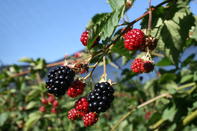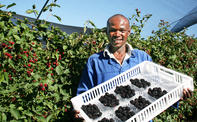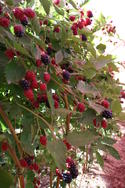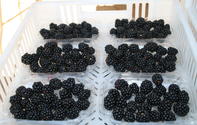The exact origin of blackberries is unknown because there are so many different species produced all over the world.

Native to Eurasia and North America, blackberries have been used as early as the Greek and Roman times as well as by Native Americans as food, medicine and dye.
The selection of plant material only started around the mid to late 1800s. While production became more common for local sales around the 1900s.
International Production
Over the past few years, blackberry production has been steadily increasing to keep up with the rising demand. This has driven by health claims incentivising consumers to eat more fresh fruit. The demand has also been growing because blackberries are such a convenient snack food with little to no waste, and makes a perfect addition to breakfast cereals and yoghurts.
The development of new varieties is helping producers to meet consumer expectations by improving the flavour, ease of production, shelflife and berry quality. The United States, Europe and Mexico are the leading producers.
Local Production

Blackberry production is small in South Africa and predicted to stay this way over the next few years. One of the greatest challenges for the industry is that the varieties grown there are not well-suited for exports. Nevertheless, new varieties are becoming available that would help to address this challenge.
Production
Blackberries thrive in deep, well-drained, acidic soils with high organic matter and is currently produced in the Western Cape, Free State, North West, Gauteng and Limpopo. Almost 80% of the crop is produced in tunnels, whereas the rest is produced in open fields.
Production Season
Blackberries are a summer fruit, with the production season in South Africa starting in November depending on the area of production and variety.
Blackberry Varieties

A range of varieties is grown, which are either trailing or erect types, with varying degrees of thorniness. The erect varieties are generally more cold hardy than the trailing varieties.
Blackberry plants take up to three years to reach maturity and remain productive for up to twelve years. In 2018, roughly 52% of the blackberries planted in South Africa was younger than three years of age and more than 40% was older than seven years, as reflected by the SA Berry Producers Association.
Sales

The SA Berry Producers Association has stated that South Africa produced roughly 225 tons of berries in 2018, of which 48% was exported, 41% was sold locally and 11% processed. More than 90% of the exports went to Europe and the rest went to the Middle East.
Uses
Blackberries are regarded as a super food, because it is rich in vitamins A, C and E, minerals, such as potassium, magnesium and calcium, as well as fibre and antioxidants. All of these nutrients are believed to aid the prevention of heart diseases.
Blackberries may be enjoyed fresh, used in baked goods, frozen or processed to be used in desserts, juices, teas, yoghurts and jams. The roots are claimed to help treat diarrhoea and dysentery. While the juice extracts are said to protect the skin against infections and premature aging.
Medical Disclaimer
Information is for educational and informational purposes only and may not be construed as medical advice. The information is not intended to replace medical advice or treatment offered by healthcare professionals.